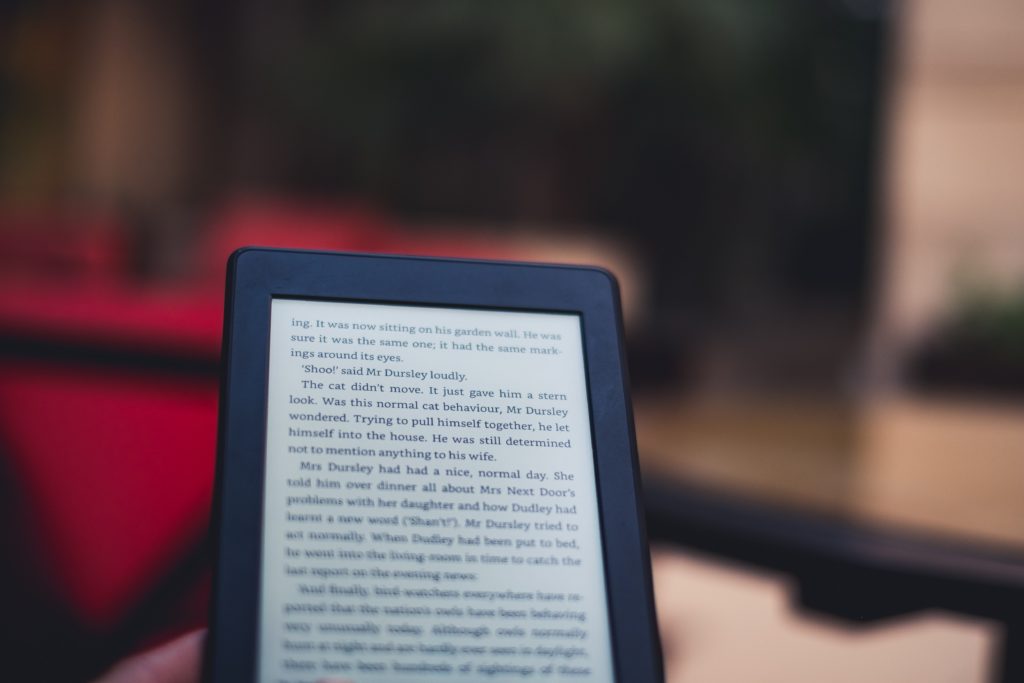
Theodore Roosevelt would have loved my Kindle.
When he left office in 1909, our 26th president, adventurer and omnivorous reader, went on safari. He brought along a 60-pound aluminum case containing his “Pigskin Library” — 50 or so of his favorite books bound in swine leather.
“Often my reading would be done . . . beside the carcass of a beast I had killed,” Roosevelt explained in his book, African Game Trails. Ordinary bindings were no match for the stains of “blood, sweat, gun oil, dust and ashes,” he wrote. They “either vanished or became loathsome.” Books bound in pigskin “merely grew to look as a well-used saddle bag looks.”
No big game hunting for me, but like TR, I carry a library. It’s the Kindle, an electronic book reader created by Amazon.com, the largest online store in America. Instead of pigskin, it’s encased in white plastic. It’s the size of a paperback and weighs 10.3 ounces. Half an inch thick, the case frames a 6-inch gray screen that displays pixilated black letters, and, sorry Mr. President, mine can hold about 200 books.
In true geek speak, Amazon calls it a “Wireless Reading Device.” Like cell phones, Kindle doesn’t need a cable or computer, only Amazon’s free high-speed connection that dispatches digitized books, newspapers, magazines and blogs to my electronic library in less than a minute. A gadget freak, I was one of the Kindle’s first buyers in 2007 and in the past two years, it has transformed my reading life.
There are two kinds of readers, those who mark up their books with abandon and don’t mind food stains, and others, like me, who prefer them untouched by anything but words on the page. When reading, I often encounter a passage worth remembering, or a word absent from my vocabulary. For a bibliophile, the choices are sacrilegious: highlighters, underlining with a pen, penciling a margin note.
I love my Kindle because it makes me a pain-free annotator. I can highlight sentences, paragraphs, add notes, bookmark pages, and look up unfamiliar words on the onboard dictionary, using its scrolling bar and cursor wheel. The Kindle stores them in a file called “My Clippings,” which I can transfer to my laptop.
You read on the Kindle with a click of “next page” and “previous page” bars. It offers six font sizes, a visual boon for a presbyopic baby boomer, and as a bonus, lets me listen to music or an audiobook. I avoid back pain on business trips by filling up my Kindle, and not my bag, with books. It’s with me on planes, in doctors’ waiting rooms, and at my bedside.
I no longer lust over new releases, unable to justify shelling out nearly $30 a pop. Amazon’s deals with publishers lets it charge $9.99 for top sellers.
I had worried that the cold feel of the Kindle couldn’t overcome a book’s pleasures of tactile immersion, but soon found I could lose myself in either medium. Print or digital, books consume me.
Curled up in bed over the recent holidays, I read, in many cases, re-read, 22 hardcover and paperback books, pulled off my shelves.
On my Kindle, I downloaded and devoured all 10 of Alan Furst’s historical espionage novels, Dostoevsky’s The Brothers Karamazov and Crime and Punishment, The Brain that Changes Itself by Dr. Norman Doidge, and Jane Mayer’s revelations about America’s torture tactics in the war on terror.
Okay, so it isn’t perfect. The keyboard is frustratingly tiny. Amazon.com claims a Kindle library of 225,000 books but I’m often frustrated by its gaps — why Sinclair Lewis’ Babbitt, but not his Dodsworth?
The Kindle can’t project a cover’s vibrant designs or illustrations, except in black and white. Newspapers and magazines are difficult to navigate on the small screen. And you can’t easily flip to the back of the book to see how the story turns out, or to see how close you are to the end.
No matter. My Kindle helps me read more books and capture their nuggets of insight and literary grace without besmirching a single page.
And it passes the bathroom test. That’s a plumbing metric of potty accessibility, which books, newspapers and other printed objects win flush down, but usually trips up water-averse digital devices. I attest that you can read the Kindle on the john. I’d stay out of the bathtub unless you don’t mind buying a new one if slippery hands dunk your Kindle.
My digital books don’t need pigskin binding. Even so, I’m convinced that, were he alive today, Teddy Roosevelt would have cried “That’s Bully!” — his trademark phrase of admiration — and snapped up a Kindle in a heartbeat.
What’s on
Chip’s Kindle?
The contents of a Kindle, like bookshelves, provide clues to a reader’s interests and obsessions. Like Teddy Roosevelt, I’m a voracious, eclectic reader. I bounce to and from subjects like a pinball — neuroscience, thrillers, literary classics.
- An Unquiet Mind, Kay Redfield Jamison
- Wolves Eat Dogs, Martin Cruz Smith
- Outliers, Malcolm Gladwell
- The Pillars of the Earth, Ken Follett
- Night Soldiers, Alan Furst
- Creativity, Mihaly Csikszentmihalyi
- Made to Stick: Why Some Ideas Survive and Others Die, Chip Heath and Dan Heath
- Healing Back Pain, John E. Sarno
- Retribution: The Battle for Japan, 1944-45, Max Hastings
- This Republic of Suffering, Drew Gilpin Faust
- Cousin Bette, Honore de Balzac
- The Ghost Map, Steven Johnson
- 1984, George Orwell
- How to Use the Amazon Kindle, Stephen Windwalker
- Good Calories, Bad Calories, Gary Taubes
(Published in the St. Petersburg Times, Feb. 1, 2009)
Photograph by Vikas Pawar courtesy of unsplash.com